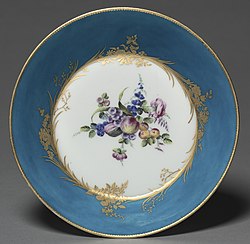Saucer
This article needs additional citations for verification. (December 2012) |



A saucer is a type of small dishware. While in the Middle Ages a saucer was used for serving condiments and sauces, currently the term is used to denote a small plate or shallow bowl that supports a cup – usually one used to serve coffee or tea.[1]
Overview
The center of the saucer often contains a depression or raised ring sized to fit a matching cup; this was only introduced in the mid 18th century. The saucer is useful for protecting surfaces from possible damage due to the heat of a cup, and to catch overflow, splashes, and drips from the cup, thus protecting both table linen and the user sitting in a free-standing chair who holds both cup and saucer. The saucer also provides a convenient place for a wet spoon, as might be used to stir the drink in the cup in order to mix sweeteners or creamers into tea or coffee.
Some people pour the hot tea or coffee from the cup into the saucer; the increased surface area of the liquid exposed to the air increases the rate at which it cools, allowing the drinker to consume the beverage quickly after preparation.[citation needed] This was very common in the 18th century.[2]
Although often part of a place setting in a tea or dinner set, teacups with unique styling are often sold with matching saucers, sometimes alone, or as part of a tea set, including a teapot and small dessert plates.
Thermal transport
When placed beneath a cup, saucers have very little direct influence on beverage cooling rate. For hot, water based beverages (e.g. tea or coffee), cooling rate in a cup is typically dominated by evaporation, which occurs across the free surface in contact with the air. Heat transfer through the bottom of the cup is small relative to heat lost through the top of the cup. Further reducing the heat lost through the bottom of the cup has little effect on the cooling rate of the beverage.[citation needed]
Placing a saucer on top of a cup, however, inhibits evaporative cooling and is thus an effective way of reducing the cooling rate so that the drink remains warmer for longer. The reduction in heat loss due to evaporation is typically much greater than the increase in heat loss associated with conduction through the saucer (and subsequent radiation or convective transfer to the surrounding air).[citation needed]
Historical reference
When Jefferson returned from France...he asked George Washington why the Senate had been created. Washington replied by asking Jefferson "Why did you pour that tea into your saucer?" "To cool it," said Jefferson. "Even so," responded Washington, "we pour legislation into the senatorial saucer to cool it."
— Floor Speech By Senator Chuck Grassley
[3][4] though the earliest publication of this supposed interchange appears to be 1872.[5][6]
Gallery
-
Department store-ware
-
Styrofoam saucer
-
Antique
-
Faience saucer of the Maison Losseau collections
See also
- Coaster, used to protect the surface where the user might place a beverage
- Plate, used to serve food
References
- ^ "Definition of SAUCER". www.merriam-webster.com. 25 March 2024.
- ^ Ramsey, Sarah (2020-11-06). "Did People Actually Drink Coffee From a Saucer?". Wide Open Eats.
- ^ "Floor Speech by Senator Chuck Grassley on How the Senate Should Work | U.S. Senator Chuck Grassley of Iowa". www.grassley.senate.gov.
- ^ "U.S. Senate: Senate Created". www.senate.gov.
- ^ Berkes, Anna; Verell, Nancy (May 1, 2016). "Senatorial Saucer". Monticello.org. Retrieved 25 June 2024.
no evidence has surfaced that such a conversation between Jefferson and Washington actually took place
- ^ Conway, Moncure Daniel (1872). Republican superstitions as illustrated in the political history of America. London: H. S. King. pp. 47–48. Retrieved 25 June 2024.
External links
 Media related to Saucers at Wikimedia Commons
Media related to Saucers at Wikimedia Commons




